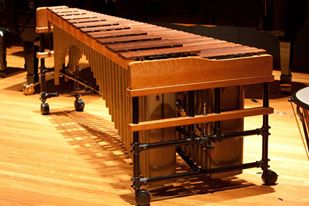Why Marimba?
 Percussion is a huge family of diverse instruments. The marimba is one of the most technically and musically developed, providing a huge register and an enormous palate of tone colours. The continued physical refinement of the instrument and increasing virtuosity of its players has inspired more and more composers to write for the marimba. Today, some of the most innovative new music – and some of the most exciting and sophisticated classical percussion music – is being written for the marimba. The development of the marimba has played a huge role in helping to raise the standard of, and respect for, percussion within the classical music world.
Percussion is a huge family of diverse instruments. The marimba is one of the most technically and musically developed, providing a huge register and an enormous palate of tone colours. The continued physical refinement of the instrument and increasing virtuosity of its players has inspired more and more composers to write for the marimba. Today, some of the most innovative new music – and some of the most exciting and sophisticated classical percussion music – is being written for the marimba. The development of the marimba has played a huge role in helping to raise the standard of, and respect for, percussion within the classical music world.
The marimba demands a combination of abilities from those who play it: the rhythmic precision of the snare drum, the sensitive attention to detail and tone colours of the orchestral percussion section, the melodic phrasing of the xylophone and glockenspiel, the harmonic function of timpani, the physical coordination of the drumkit.
For school-aged percussionists, the marimba can present an impressive challenge. Those brave enough to give it a go can find themselves in new and exciting musical worlds. The marimba can be played in a variety of musical contexts: in percussion ensembles, mixed chamber music ensembles, as a solo instrument with or without accompaniment and even in bands and orchestras. It can also be used in a variety of musical genres; not just weird and wonderful new music but also in jazz, pop and movie music. And through transcriptions, marimba players can borrow music from other classical instruments going back as early as the baroque period.